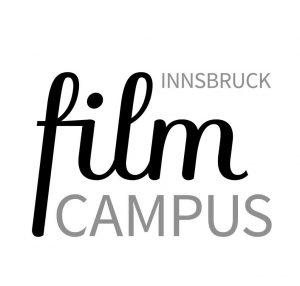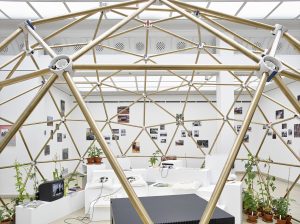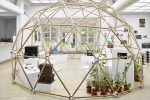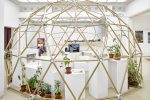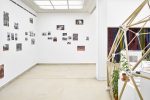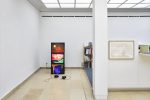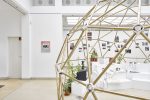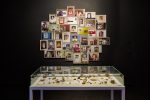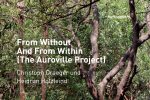From Without And From Within (The Auroville Project)
Christoph Draeger, Heidrun Holzfeind

A golden structure – a geodesic dome – is standing at the centre of the Kunstpavillon. Inside this spherical dome there are rows of seats equipped with cushions, like in a small amphitheatre, which invite visitors to sit down.
In the exhibition From Without And From Within (The Auroville Project) Christoph Draeger and Heidrun Holzfeind are presenting the results of three years research into the Southern Indian town of Auroville, founded in 1968, reporting on the social-utopian ideas that its residents have attempted to realize in the realities of life since. They invite us to view videos, books and archive material on the subject, and to discuss ideas and suggestions for communal life in the future. Even before entering The Golden Dome, as the two artists call their spatial structure, we are given first indications of the social form potentially implemented in Auroville for almost 50 years now – on the left, right by the entrance is the work LIFE WITHOUT MONEY, a gouache onto which an historic press photo and a text are glued to form a collage: “LIFE WITHOUT MONEY, Pondicherry, India: the resident head architect here, Roger Anger, who was born in France, designed these basic housing units for the new community of ‘Auroville’ nearby. The huts are made from concrete, steel, wood, asbestos and roofing straw, so providing a simple, reasonably priced roof over their heads for the people living here.”
Inside the dome, the video The Auroville Archives provides information on the town’s foundation by “the Mother”, as French-born Mirra Alfassa is called even to the present day; on the “Charta”, the “constitution” of Auroville that has been translated into 16 different languages, and on the initial idea to create a laboratory for new forms of social cohabitation for 50,000 inhabitants. The archivist of Auroville, the city of the future, reports on a modern city-state where there is no money and no prison; instead, food, housing and clothing are available to all.
It is all about a spiritual way of life without religions, whereby the focus is on education. Knowledge is passed on in a “happy” environment, in which the individual learns “to be”. Lifelong learning and striving for self-awareness are symbolized by the landmark of the city, which also functions as a place for meditation. The Matrimandir is a huge golden sphere, also a geodesic structure, which is known as the soul of Auroville. In the left-hand wing of the Kunstpavillon, Christoph Draeger and Heidrun Holzfeind are showing the photo installation Growing Within, comprising re-photographed archive images as well as recently taken colour photographs. In the historic and current photos we see modernist buildings in addition to the Matrimandir, simple huts, and situations in the city, as well as other geodesic constructions used for housing or as greenhouses. Due to their simple but extremely stable construction, such apparently futuristic spatial structures are very popular with people who prefer alternative ways of life, and the US-American hippies also use(d) this building method. The Golden Dome by Draeger and Holzfeind is fertile soil, a range of plants grow there – maize, papaya or various types of bean, for example –, cultivated for the two artists by Innsbruck Federal Gardens using seeds that came from Auroville.
The artists have visited the community in which approx. 2500 people from 53 nations[1] live four times in recent years, and they use one point from the Charta of Auroville not only as a title for their exhibition in the Kunstpavillon but also as the starting point in their artistic approach to the project:
- Auroville wants to be the bridge between the past and the future. Taking advantage of all discoveries from without and from within, Auroville will boldly spring towards future realisations.
Christoph Draeger and Heidrun Holzfeind have developed a strategy for From Without And From Within (The Auroville Project) that combines observation from the outside with the inner view, and so it seems like a logical development not only to concern themselves with the people of Auroville but also to involve people from their own professional and private sphere in the project. In a workshop entitled Re-Imagining Utopia held in May 2017, they developed suggestions for possible interventions and public works of art in Auroville together with students from the College of Art in Umeå, Sweden. Auroville, which will be celebrating 50 years in existence in 2018, certainly has a wealth of experimental architecture, and creativity is an important part of its self-image; nevertheless, there are very few public or contemporary artworks in the city today. The results of the workshop, as well as newly produced and existing works by artists in their circle of friends, who Draeger and Holzfeind asked to reflect upon the idea of a utopian community in the 21st century, are being shown as a group exhibition under the title Re-imagining Utopia (The Auroville Project) within the exhibition From Without And From Within (The Auroville Project).
The works by Carolina Andreasson, Jessika Björhn, Andrew Burton, August Bällgren, Christoph Draeger, Martin Ebner & Ariane Müller, Charlotte Hedberg, Swetlana Heger, Heidrun Holzfeind, Nadira Husain, Elka Krajewska & Gregor Neuerer, Tryggve Lundberg, Gazi Mrah, Klaus Weber and Olav Westphalen are placed inside or respectively around the geodesic dome, and together with the archive materials they generate a map of ideas enabling visitors to engage with the Auroville project in an open, creative way.
Entering through the PVC curtain in the colours of the rainbow, Sometimes There Is Nothing (Colors of Auroville), into the darkened back room of the Kunstpavillon, first one’s eye is caught by an installation lit in an almost sacred manner. This clarifies the idea of “Auroville” with its ambivalence. In a glass case one can see gemstones that Vijay, one of the first Aurovilians, gave as a gift to the artists’ son, in addition to other artefacts like a brooch dating from 1968, or butterflies from Auroville. Hanging behind this there is a frieze of 38 framed photos (printed on bamboo paper), which show altar-like still-lifes comprising the types of images of the Mother omnipresent in Auroville. Mothers, with its concentrated configuration, makes the thin line between an open society and dogmatic discipleship obvious. Life in and with nature, and the significance of research and education in an envigorating environment stand in contrast to a spirituality that sometimes seems to tip toward the worship of saints, although a lack of religious confession is regarded as the key to life in peace, unity, and harmony.
In the two video works What is Auroville? and Nine Palms Christoph Draeger and Heidrun Holzfeind approach the people who actually live in Auroville. In What is Auroville? inhabitants of various origins and different ages report on what life in Auroville means to them. Besides the personal motivations and challenges leading them to live here, the focus here is on architecture, ranging from the constructed visions of the French head architect Roger Anger to the ship’s container that a young artist has set up for herself at the edge of the settlement. She also reports on her difficulties with the Indian population living in the immediate vicinity and their lack of understanding that she is living alone as a young, unmarried woman. One vegetable farmer highlights another discrepancy when he reports on how Auroville wants to be self-sufficient in terms of agricultural products, yet says in the next moment that tomatoes, which do not grow here all year round due to the climate, have to be imported because the Aurovilians don’t want to do without them. Nine Palms – named after the nine palm trees that define one section of land inhabited and cultivated by a family originally from Germany – draws a subtle portrait of a family centred on their dying father, who talks, among other things, of how motorization – which he has always opposed – has entered the family through his children and their friends. It seems that conflict between the generations cannot be ruled out, even in ideal-typical communities. The son, who was born in Auroville in 1976, reports that as a child he often played with the children of the indigenous Tamil population, and that as a result he speaks the local language fluently. Today, as the community has grown and there are schools in Auroville itself (by contrast to the early years), only a very few Aurovilian children still speak Tamil. The daughter, carrying her baby from the second generation born in Auroville in her arms, says that after longer periods living in Berlin she has now made a conscious decision in favour of the way of life in Auroville. The family live, grounded and – or such is the impression – quite contentedly on their piece of land, and seem to have taken on board the basic values of Auroville’s philosophy, while still appearing very “normal” and not striving for the noble aim to lead humanity as a whole toward a state of unity.
Christoph Draeger and Heidrun Holzfeind employ different means – using discoveries from within and without and keeping in mind the “perpetual learning process” that is proclaimed in Auroville – to approach the town and its residents, and make clear with What is Auroville? and Nine Palms that the gaps between idealized theory and life as it is lived are both productive and exploitable.
Ingeborg Erhart
[1] https://www.auroville.org/contents/3329, last accessed on 04.09.2017
Thanks to:
![]()
![]()
![]()
![]()
![]()
![]()
in cooperation with filmcampus 